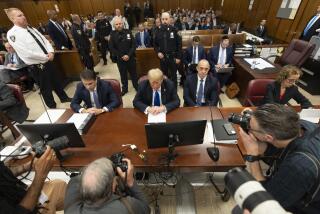Deliberations Came Down to a Single Memo
- Share via
HOUSTON — After 21 days of testimony and thousands of pages of evidence--not to mention a ton of shredded documents--it came down to one document: an e-mail by Arthur Andersen lawyer Nancy Temple suggesting changes to an internal memo regarding a press release announcing Enron’s earnings. Temple’s editing, the jury decided, amounted to impeding a government investigation and made Andersen guilty of obstructing justice.
Defense lawyers and prosecutors were stunned by the revelation that a stray memo had become the “smoking gun” that broke the panel’s deadlock and that the testimony of a high-profile prosecution witness had no effect. But jurors were sure of the reasoning that led to their unanimous decision to convict the once-venerable accounting firm.
“Arthur Andersen set about to change things, to alter documents,” said jury foreman Oscar Criner, a computer science professor at Texas Southern University in Houston. “It’s against the law to alter the document with the intent to impair the fact-finding ability of an official proceeding.”
Criner was among four jurors who spoke to the media after rendering their verdict in U.S. District Court in Houston. The panel had been sequestered during deliberations.
Andersen said Saturday that it plans to appeal, citing what it called the judge’s flawed jury instructions and erroneous evidentiary rulings. However, the firm notified the Securities and Exchange Commission that it will cease auditing public companies Aug. 31.
Ten days earlier, it was a subdued group that filed into the jury room on the first day of deliberations. There were nine men and three women from all walks of life, including an airline executive, a maker of floor tiles and a pastry chef who during jury selection said he didn’t know what the Securities and Exchange Commission did.
Their first job was to understand the jury instructions, 12 pages of law meant to guide them through deliberations.
“They were not very easy reading. All of the jury studied those charges several times over several days. It was a complex piece of logic that the judge gave us,” Criner said. “Then we looked into our initial opinions about what was going on. That took probably the first week.”
The first vote showed the panel split 6 to 6. The jury sent a note to the court asking for highlighters and Post-It Notes. They would tackle their job with precision and order.
On one board in the jury room they listed rules of conduct: Respect the opinions of others, only one person talks at a time, don’t call each other names. “We tried to maintain a civil atmosphere and worked diligently toward the end,” Criner said.
On a second board, jurors listed names of Andersen partners who might have “corruptly persuaded” employees to impede a government investigation. On the list were Andersen employees David B. Duncan, Nancy Temple, Tom Bauer and Michael Odom. As the days passed, the names were crossed off one by one.
The testimony of Duncan, who had pleaded guilty to obstruction of justice in return for leniency and was a witness for the prosecution, factored little into the panel’s deliberations. The former lead auditor of Enron had little credibility, Criner said.
“It was very clear that he had a lot of baggage that came along with him that indicated he was capable of not telling the truth,” he said.
Added juror David Schwab: “I don’t think we ever focused on David Duncan. I don’t think we even talked about whether he committed a crime or not.”
Criner described deliberations as long stretches of quiet reading punctuated by group discussion. There were reams of materials to study and absorb, in addition to their own voluminous notes. Juror Jack Gallo, the airline executive, said he took 140 pages of notes during the trial. “There were jurors that had more,” he said.
By Day 7 of deliberations, the jury was at an impasse. The vote was stuck at 9 to 3 in favor of conviction. No one was willing to budge. “It became useless--we were deadlocked,” said Criner, who was ready to vote for acquittal.
The jury then sent a note to Judge Melinda Harmon. They were deadlocked, they wrote. Harmon, using what is called an Allen charge, sternly instructed them to keep trying, reminding them of the expense of the trial and suggesting that if they couldn’t reach a verdict, probably no jury could.
As they filed back to the jury room, the chastened panelists pondered Harmon’s orders. “We started reading and studying the evidence that was about that high,” said Criner, opening his arms some 3 feet wide to demonstrate the immensity of the task.
The list of potential “corrupt persuaders” loomed on a board before them. “I have no idea what [the deadlock] did to the court. I know what it did inside the jury room. We looked at all these different people [on the list] and [asked], ‘What are we going to do here?’ ”
The jurors agreed that an Andersen employee corruptly persuaded employees to impede a government investigation.
But they couldn’t agree on which Andersen employee that was.
Out went another note to Harmon. Must we agree on the same corrupt persuader in order to convict? While the attorneys for each side argued for a response that would favor their position, the jurors doggedly continued deliberating.
Late Friday afternoon, Harmon told the jury that they need not unanimously agree on a corrupt persuader.
By that time, their question was moot. “We had agreed on one,” said juror Schwab.
It was Nancy Temple, because she was “the author of that particular memo that was altered,” Gallo said.
Criner called the memo “a smoking gun.”
“We began to look at the smoking gun and said, ‘This is not what it ought to be.’ ”
After reviewing testimony about Temple’s role in editing the memo, “we came back and said, ‘Well, here’s our verdict,’ ” Criner said.
Since jurors zeroed in on one lone memo out of thousands of pages of documents, evidence that lawyers thought crucial to the case was essentially discounted.
Prosecutors had argued that Andersen promoted its document retention policy, which called for the shredding of extraneous documents, just as the SEC began to investigate the accounting firm’s audit of Enron’s books. Criner and other jurors could not have cared less.
“I didn’t do anything with it,” Criner said. “I discredited most of that. All this business about telling people to shred documents was circumstantial and superficial.”
Before the trial, it was pastry chef Schwab who told the court he didn’t know what the SEC did. “I know what it is now,” he said ruefully. On Saturday, all he wanted to do was to head home. “I’m going to watch TV and talk on the telephone,” he said.
More to Read
Inside the business of entertainment
The Wide Shot brings you news, analysis and insights on everything from streaming wars to production — and what it all means for the future.
You may occasionally receive promotional content from the Los Angeles Times.










